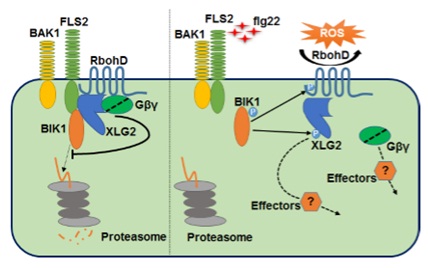The Arabidopsis immune receptors such as FLS2 perceive a variety of microbial molecules to activate a variety of immune responses through the central kinase BIK1. Recent reports showed that the heterotrimeric G proteins composed of the non-canonical Gα protein XLG2/3, the Gβ protein AGB1, and the Gγ proteins AGG1/2 are required for FLS2-mediated immune responses, but underlying mechanism remains unknown.
The research group led by Dr. ZHOU Jianmin at the Institute of Genetics and Developmental Biology, Chinese Academy of Sciences, collaborated with the group of Dr. ZHANG Yuelin at University of British Columbia, reported that the aforementioned G proteins positively regulate plant immunity by directly interacting with the FLS2-BIK1 immune receptor complex.
They found that prior to activation by flg22, a conserved bacterial flagellar epitope, the G proteins attenuate the proteasome-dependent degradation of BIK1, ensuring optimum signaling competence. Upon activation of the FLS2-BIK1complex by flg22, BIK1 directly phosphorylates XLG2 in the N terminus to regulate reactive oxygen species production, likely through modulating the NADPH oxidase RbohD.
This study demonstrates that the G proteins are directly coupled to the FLS2 receptor complex and regulate immune signaling through both pre-activation and post-activation mechanisms, highlighting remarkable similarities and striking differences in heterotrimeric G protein-coupled receptor signaling in animals and plants.
The results entitled “Arabidopsis heterotrimeric G proteins regulate immunity by directly coupling to the FLS2 receptor” were published online in
eLIFE (
http://dx.doi.org/10.7554/eLife.13568) on April4, 2016.
The study was supported by Chinese Natural Science Foundation, Chinese Ministry of Science and Technology and CAS Strategic Priority Plan.
Model for G protein-coupled FLS2 signaling. In the pre-activation state, the heterotrimeric G proteins composed of XLG2/3, AGB1, and AGG1/2 interact with the FLS2-BIK1 complex. Stimulation by flg22 induces BAK1-FLS2 interaction and activation of the receptor complex. This leads to the activation of the G proteins and phosphorylation of XLG2 in the N terminus. The activated G proteins dissociate from the receptor complex and regulate RbohD and other downstream effectors to positively modulate immune responses. (Image by IGDB)





